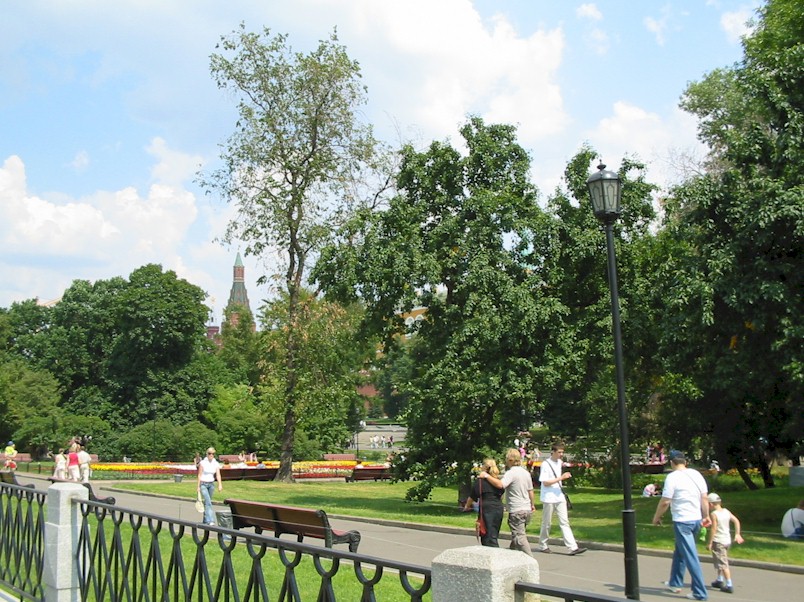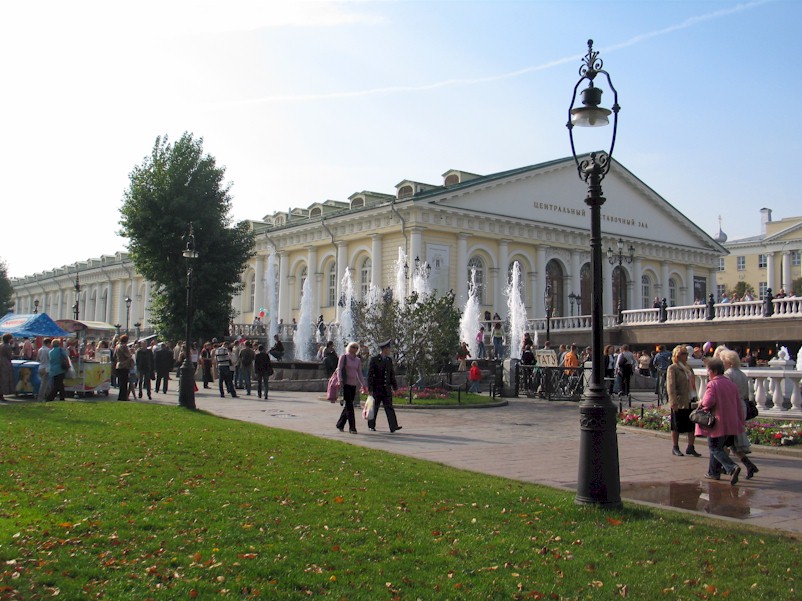The Alexander Garden
English > Locations > Locations from the novel > The Alexander Garden
Context
At the beginning of Book II of The Master and Margarita, in chapter 19, Margarita is sitting on «one of the benches under the Kremlin wall, settling herself in such a way that she could see the Manege». The funeral procession of Mikhail Berlioz, decapitated by a tram, passes by, probably going to Дом Союзов [Dom Soyuzov] or the House of the Unions in de Bolshaya Dmitrovka ulitsa and its famous Колонный зал [Kolonny zal] or Colonnade.
The place where Margarita is sitting, is called the Александровский сад [Aleksandrovskiy sad] or Alexander Garden. The word «garden» is a bit misleading, because it is a 10-hectare park.
She's accosted by Azazello, a «fiery redhead with a fang», who confirms to her that her beloved master is still alive. He asks her to be the hostess at the Satans' ball at Woland's and gives her a cream with magic power. When Margarita expresses her fear that she is «drawn into some shady story for which I'm going to pay dearly», Azazello suddenly disappears and the real adventure begins for the master's lover.
Alexander Garden
The Alexander Garden was one of the first public parks in Moscow. It was laid out in 1819-1823 to a design by Osip Ivanovich Bove (1784-1834) and named after the reigning emperor Alexander II (1818-1881). It occupies all the length of the western Kremlin wall in front of the Moscow Manege.
The garden - or rather: the park - park comprises three separate gardens, which stretch along the western Kremlin wall for 865 meters. It follows the former riverbed of the Neglinka river, which was encapsulated in a huge underground pipe.
In 1913, when the third centenary of the Romanov tsars dynasty was being celebrated, they erected an obelisk in the Upper Garden. Five years later, it was reconstructed by the bolsheviks into a monument to the Russian Revolution.
In 1967, the Tomb of the Unknown Soldier was constructed with an eternal flame brought from the Field of Mars in Leningrad. The tomb contains the body of a soldier who fell during World War II, the Great Patriotic War, at the kilometer 41 marker of Leningradskoe Shosse, the nearest point the forces of Nazi Germany penetrated towards Moscow.
The Manege
Margarita could see the Manege. This building was also built by Osip Ivanovich Bove after the war with Napoleon Bonaparte (1769-1821), after a design of the Spanish engineer Agustín de Betancourt y Molina (1758-1825).
Originally, as it's indicated by its name, the 180 meters long building was a riding academy or manege. Later it was used as a concert hall. In 1867 Hector Berlioz (1803-1869) and Nikolay Grigoryevich Rubinstein (1835-1881) played there for a crowd of 12.000 people. In Bulgakov’s time the building was used as a garage and a depository for the Kremlin.
Later, in the fifties, the Manege was renovated with the aim to turn it into a permanent exhibition hall.
But on March 14, 2004, the night of the presidential elections, it burned completely down. It was entirely rebuilt and on February 18, 2005, the Manege reopened with the exhibition which was planned for the day it had burned down.
Share this page |

